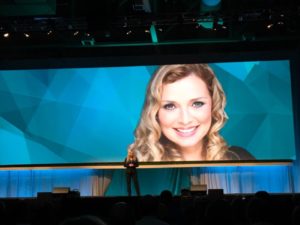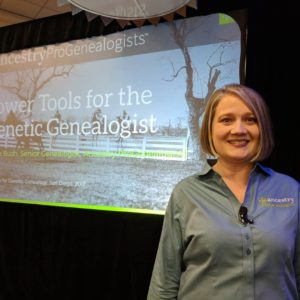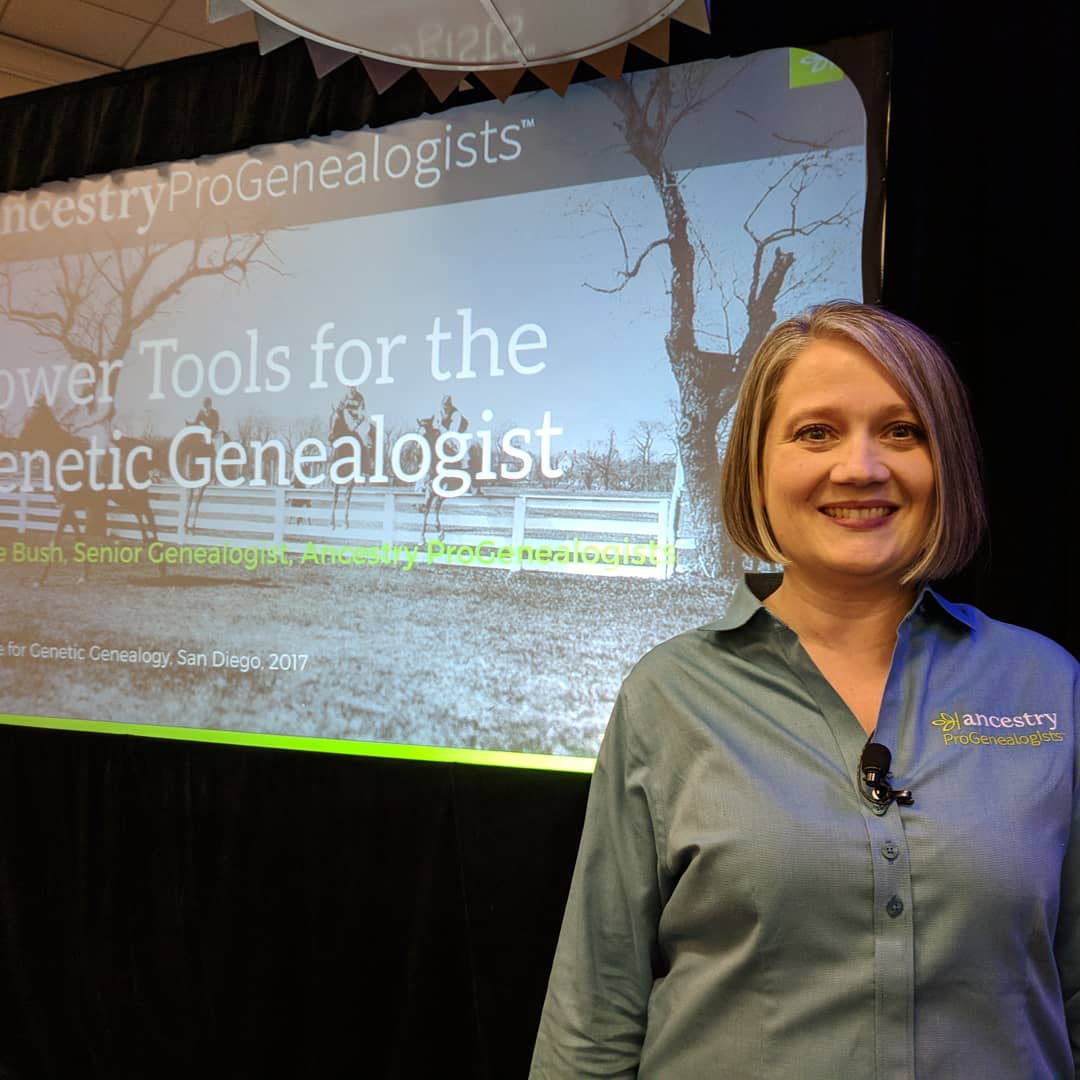Here are some highlights from my notes of the three presentations I attended Saturday afternoon at i4GG 2017 DNA Conference in beautiful San Diego. The conference videos will be available to purchase February 1, 2018 and I recommend that! My notes only contain a portion of what the speakers shared.
Creating and Utilizing Genetic Networks by CeCe Moore

There is segment triangulation and there is pedigree triangulation. Dr. Ann Turner, one of our great citizen scientists, said in part: “…Insisting on triangulated segments…mask(s) a broader overview of connections between people.”
Pedigree Triangulation: Comparing trees and identifying common ancestors.
Run “Shared Matches” on Ancestry of all matches 3rd-4th cousins and closer (There is a Shared Matches tab for each match.)
On FamilyTreeDNA, it’s called ICW (In Common With) matches.
- On FamilyTreeDNA, click enter after searching surname.
On 23andMe it’s called Relatives in Common for those who choose open sharing.
- Scroll all the way down to find Relatives in Common tab.
Hit clear after each search at FTDNA and at 23andMe.
Run shared matches with each of the individual shared matches generated from the task above.
Work with the trees to determine a likely shared ancestral line.
Create a group you believe belongs to one network.
Use filters such as surname or birth location to find them, too.
If you put the surname in the search filter, it will pull more distant matches that Shared Matches does not. Shared Matches only pulls predicted 4th to 6th cousins and closer.
Run shared matches on all matches 3rd-4th cousins and above, plus their shared matches, then group.
Do you get consistent results of shared matches?
Confidence levels should increase as we:
- Notice patterns in the matches
- Identify shared common ancestors in the trees (vet the trees)
- Check family trees for obvious errors, sources and depth
- Vet the research (redo it)
- Triangulate segment data on GEDmatch.com (or FTDNA or 23andMe)
Shared matches cluster #1. Identify repeating ancestors in others’ trees.
Shared matches cluster #2. Identify a target couple repeated in trees.
Look for where the trees intersect.
Use Google maps to check distances of key locations (Example: Address of a family on a 1940 census and distance to the location where a foundling was left. Is it walking distance?).
She covered ways to identify matches who have not responded to messages (or if you are wanting to identify them before sending a message).
Places to check for usernames or to determine the identity of a match with a common name:
- pipl.com (Free, if you don’t click on sponsored links)
- usersherlock.com
- GenealogyBank (subscription site – amazing resource)
- Intellius – without subscribing you can still see associates sometimes.
- Spokeo, if you have a subscription. There is a username search field, unlike many other public record search sites.
- BeenVerified, if you have a subscription. Put in ancestral location from a genetic network. Parents can be on their list of associates even if they have been deceased since 1990.
If you only have initials and a manager’s name, research the manager. Check their profile carefully (including message board posts). Look for them on Facebook and look at their list of friends. If their list of friends is private, look at who liked their photos (often, close family members).
Homework: Create genetic networks (by checking shared matches and creating groups of matches) for your first page (top 50) AncestryDNA matches.
CeCe’s DNA blog is yourgeneticgenealogist.com
Power Tools for the Genetic Genealogist by Angie Bush, Ancestry ProGenealogists

Angie showed us example pages in her slides of the Research Journal the Ancestry ProGenealogists Unknown Parentage Team puts together for each client with unknown parentage.
The Research Journal contains the following elements, not necessarily in this order or all-inclusive:
- Match cluster worksheet
- Written summary for client
- Research Objective at the top
- Source
- Purpose of search
- Finding/analysis
- Document number
- Any non-identifying information or client provided info
- Provided tree
- Overview of DNA results
- Admixture and Migrations (formerly called Genetic Communities by Ancestry)
- Close matches over 90 cM not sorted
She demonstrated Jonny Perl’s tool on DNApainter.com with probabilities for relationships.
Connecting DNA and records:
- Connect to a paper trail
- Genealogical research is required to identify common ancestor(s).
Pyramid visual: If you can’t find the ancestor by going up (one or more generations are missing), try to come back down the other side from an identified distant ancestor.
Write everything down and keep good notes!
Close matches share 90 cM or more.
MyHeritage has a shared match tool.
- Matches one or both of one or more kits.
GWorks (Third party tool from DNAGedcom Client) is good for common surnames.
Write down specific close matches.
Cite individual matches, putting shared matches next to each other in a journal.
Cite public records databases.
LucidChart.com – free or paid version
- Use to chart out a family tree so you have a visual
- Name your document
- Change both arrow direction boxes to “none” so no arrows on your lines
- Fill box
- Drag shapes from side
- Arrange boxes where you want
- Add lines last
- Put relationship to tester under the box
Match cluster worksheet:
- List all first cousins
- Cross out those who are not descended from both sets of ancestors.
Illustration: Hypothesis vertical family tree.
“A centiMorgan (cM) is a unit of measure used to describe how much DNA (inherited from a common ancestor) is shared between two people.”
They use GWorks pedigree power tool in 5-10 % of cases for more distant unknown parentage.
- Can search birth and death locations.
- Can search for specific John Smith.
- Requires files from DNA Gedcom Client.
- Needs ancestry login.
- Gather matches and gather tree.
- Click “quicker match gather” button.
- Upload match’s file and upload trees
Part of what is included in a report to a client:
- Example: “You asked us to find your biological father. We have identified him as —- of (location).
- Research methodology – simplified.
- Info on bio father (for example).
- Restate info.
(Sidenote: Laura, someone on the team, told me earlier – when I mentioned I had a new DNA search and reunion stories blog – that they don’t get to hear the follow-up and reunion stories from their clients very often, or what happens after they close the case.)
Audience questions:
Dawn asked what GWorks does. It groups matches from all trees.
- Gedcom can be added.
- Hyperlinked. Right-click file link to go to the page.
- Grabs public member trees that are attached to DNA
- Is GWorks compatible with Mac? Not now, but it will be. Angie gets it to work with Mac.
The Research Journal is shared with the client and is usually 10-20 pages long.
Someone asked the average time they spend on a case. She said about 20 hours on average.
They have a match tracker system at ancestry while waiting for a closer match because sometimes they reach a point where a closer match is necessary to proceed.
They can and will reach out to biological family members by snail mail.
Someone asked if they use mirror trees. She said, no, that they haven’t since about 2014- 2015 and it seems so long ago, like “the dark ages” when she and CeCe did mirror trees. It is not usually necessary anymore.
Someone asked their rate for clients:
- Base rate $125/hour
- Rush rate $150/hour
- I believe I heard at their office in January during SLIG that clients contract for a minimum number of hours (15 or more?) or that there is a minimum package.
- They offer consultations for $500 when they can see the client has close matches and they will only need to spend about three to three and a half hours average doing research, writing it up and conveying the information.
PeopleFinders subscription site for public records was mentioned.
Someone said they wished there was a better way to sort and group matches on Ancestry site. She said, “Hopefully it’s coming,” so we can anticipate that!
Science the Heck out of your DNA: Using Hypotheses and Probability to Solve Complex Genealogical Problems by Leah Larkin, Ph.D.
Hypothesis testing
Hypothesis: Possible explanation for some observations.
You’re trying to prove that the hypothesis is wrong.
If it’s not wrong, it could be right.
Hypotheses are meant to be challenged.
Competing hypotheses example: Two different brothers could be the unknown father you are seeking.
Hypothesis testing illustration with tweaks from Ancestry White paper (Figure 5.2 2016)
- Low end of range for one relationship and high end of another range for a different relationship can overlap.
- Logarithm scale – Intuitive to almost no one on the planet (but she gets it).
Clarification by Leah: Numbers for DNApainter came from Ancestry, not from Leah.
Combined probability of independent events: Odds are 15 to one for her example.
Jonny’s working on a new tool which calculates multiple relationships. This is the beta for those who want to check it out:
dnapainter.com/tools/prob1?m=[]
She showed us two case studies. Case study #1 was a German whose grandfather was an unknown US GI. Of five possibilities in a family, one hypothesis was 125 times more likely (after using dnapainter to run comparisons).
You want the odds to be at least 10-20 times more likely.
She prefers everything in one figure for a family tree chart.
Calculating the odds shows you where to focus targeted testing in the future. You don’t have to scattershot test when you figure the odds first.
Don’t forget to consider the “half” relationship possibilities.
Acknowledgments:
- Tobias Kemper
- Andrew Millard, UK, wrote calculations for an early version of the DNApainter tool.
Leah has a blog at theDNAgeek.com
I’ll post my notes from Sunday presentations later this week: Using DNAGedcom’s GWorks by Rob Warthen; Breaking Down Genealogical Brick Walls with AncestryDNA by CeCe Moore; Searching for Family in an Endogamous Population by Kathleen Fernandes; Genetic Genealogy Year in Review closing keynote by Blaine Bettinger
